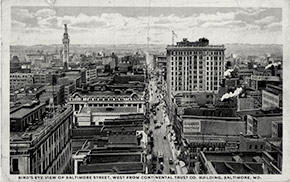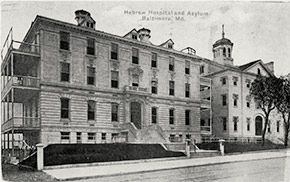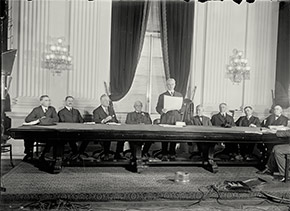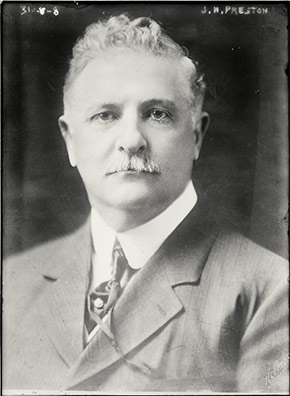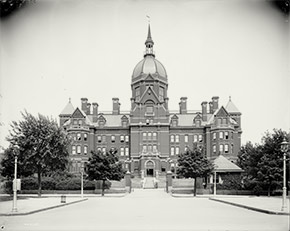Produced by the University of Michigan Center for the History of Medicine and Michigan Publishing, University of Michigan Library
Influenza Encyclopedia
The American Influenza Epidemic of 1918-1919:
A Digital Encyclopedia
Baltimore, Maryland
50 U.S. Cities & Their Stories
On September 24, 1918, a small number of influenza cases among soldiers at Camp Meade–some 25 miles north of Baltimore and on the route to Washington, DC–were reported to military medical officers. The victims were believed to have contracted the disease while away from camp. Each sick soldier was isolated immediately, but no further actions were taken; for the time being, visitors were still allowed to enter the camp and soldiers were allowed to visit Baltimore
on leave.1
The disease moved with amazing rapidity, and within a few days there were 1,900 soldiers at the camp ill with influenza. Officers quickly implemented measures to slow or halt the spread of the disease. Large gatherings were banned, and the Hostess House, theater, and base YMCA were closed. Civilians were barred from visiting, except valid employees, and no soldier was permitted to leave the camp.2 Meanwhile, approximately 300 cases of influenza were reported at Fort McHenry, the famous Army installation from the War of 1812 and now home to a large military hospital complex, and nearly 1,150 cases at the Aberdeen Proving Ground in Edgewood, some 25 miles up the Chesapeake Bay from Baltimore.3 As the disease ravaged the nearby military installations, Baltimore’s thousands of civilian contract laborers who worked at Camp Meade, Fort McHenry, the Proving Grounds, and area shipyards brought more than their dinner pails home at the end of the day, infecting themselves, their families, and associates with influenza. The city health department would later report that the first ten cases of influenza to strike Baltimore’s civilian population occurred in late-September among these laborers.4 From this small batch of cases would follow Baltimore’s influenza epidemic.
Initially, while Baltimore newspapers focused on the thousands of military cases being treated, city Health Commissioner Dr. John D. Blake maintained that he was not worried about a similar outbreak among civilians. On September 26, he announced that the influenza circulating in the area was the “same old influenza the physicians have recognized and treated for a good many years.”5 Likewise, the chief of the communicable diseases bureau of the Maryland Board of Health, Dr. C. Hampson Jones, said that the situation around Baltimore was not alarming. Unfortunately, it soon would be.
Several days later, on September 29, the health department admitted that influenza cases were increasing in the city, but officials were unable to estimate the actual numbers since influenza was not yet a reportable disease in Baltimore. Blake still did not believe the situation was serious enough to warrant “drastic measures,” a position he would continue to hold.6 On October 1, Blake did ask the United Railways Company and the city’s theaters to keep their streetcars and spaces well ventilated and to post signs reminding patrons to use their handkerchiefs when coughing and sneezing.7 It was a start. Baltimore’s Mayor James Preston felt that Blake “should have a free hand to deal with existing conditions and to use every means within his power to check any further spread of the disease.”8 Yet Blake, meeting with a group of ten prominent city and state physicians, decided that no public good would come from implementing more active interventions at this time. When a group of physicians from the Hospital Conference Associate criticized Blake for his inaction and asked Mayor Preston to make provisions to relieve hospital overcrowding and to ban public gatherings, Blake angrily asked what the point of such a move would be. “[E]very day and night there are tremendous gatherings in the interest of the [Liberty] loan,” he told them. “Then imagine if you can what it would mean if we put a sudden stop to all such meetings. We no not consider such drastic steps necessary in view of the extreme low civilian death rate in the city.”9 For Blake, the supposed fear that a closure order would cause was worse than the epidemic itself.
The death rate may have been low thus far, but the number of new cases was quickly overwhelming Baltimore’s hospitals, nurses, and physicians. By October 6, there were already so many residents sick with influenza that the city’s hospitals were unable to accept new patients. The Volunteers of America offered their headquarters building as a temporary hospital, and residents were called upon to donate sheets, blankets, and pillows to help prepare it for patients. The small emergency hospital was ready three days later, but its twenty beds were hardly enough.10 City businesses struggled to maintain their operations in the face of high worker absenteeism. The Chesapeake and Potomac Telephone Company reported 250 of its operators and some 25% of its total workforce out sick with influenza.11 United Railways, which operated Baltimore’s streetcars, reported 300 motormen and conductors sick.12 Blake came under increased attack by physicians and public health officials crying for action. One physician called it “absolute suicide for our people” for Blake not to issue a closure order. Another said that schools, churches, and theaters should be closed at least for a short while, as the city was experiencing the height of its epidemic and “conditions at the present time are exceedingly alarming.”13
On October 8, the school board decided to take unilateral action and to close all public schools until further notice, over Blake’s strenuous objection. A staggering 30,000 students and 208 teachers were absent on October 7 alone, Superintendent C. J. Koch explained, and there was simply no way to keep schools open and functional. A number of private schools, facing similar absenteeism problems, followed suit.14 Blake finally relented. In step-wise fashion, he implemented a series of public health measures intended to halt or slow the spread of the epidemic. On October 9, he issued an order prohibiting public gatherings and closing theaters and other places of public assembly.15 The next day, Blake restricted the business hours of department, retail, and specialty stores. Saloons were spared from either closure or business hour curtailment because of the purported medicinal value of liquor. The health commissioner also ordered United Railway to keep its streetcars ventilated and to prevent overcrowding.16 On October 11, he ordered all churches and poolrooms closed, and hinted that saloons might have to close as well. The next day, Blake ordered dentists to wear gauze masks while with patients, and limited the operating hours of saloons and bars to 9:30 am to 4:30 pm.17
Within a week, the number of new influenza cases being reported daily began to decline, although, given Baltimore’s slow response to the crisis, this was most likely due to the epidemic running its natural course than to the recent social distancing measures enacted. The death toll, however, continued to mount. Caskets, as well as the labor to prepare graves, were in short supply. Families, many of them living paycheck-to-paycheck, could simply not afford the expense of one or more funerals in the family. Mayor Preston and city council appropriated $25,000 to help defray funeral costs for poorer families. To lower funeral costs, the health department temporarily allowed burials without embalming. The department also secured fifty workers from the highways and water departments to dig graves, and helped obtain a supply of coffins.18 East Baltimore, the city’s immigrant neighborhood, was especially ravaged by the epidemic. Crowded housing and unsanitary conditions caused by a lack of resources placed many of Baltimore’s recent arrivals at higher risk of contracting influenza. To help alleviate conditions there, Blake asked the Y.M.C.A., Knights of Columbus, and the Jewish Welfare Board to direct their attention and activities to the poorer sections of the city, and in particular to help immigrant families.19
Baltimore’s immigrants were not the only group facing added hardship. With the exception of the Johns Hopkins Hospital and Bay View (for the city’s poor and the insane), the city’s African Americans were admitted to Black-only hospitals.20 This color line affected not only the sick, but the deceased as well. By October, the city’s African American cemetery, Mt. Auburn, was overwhelmed with caskets and not early enough graves. Few city employees were willing to dig graves for Blacks. When a call for volunteer gravediggers went unanswered, Mayor Preston appealed to the War Department for assistance. In response, 342 African American soldiers, along with a minister, were assigned the task, which they completed in a single day.21
By late-October, only two weeks after taking action, Blake decided that the epidemic situation in Baltimore was looking good enough to remove some of the restrictions on public gatherings. Beginning on October 26, retail stores would be allowed to operate from 9:00 am until 5:30 pm, while movie houses, theaters, poolrooms, and lodges could open from 7:30 pm until 11:30 pm. Churches could hold services from 5:00 am to 3:00 pm. Movie house and theater owners protested the restricted hours–which prohibited them from showing matinees–but to no avail. “While we ought to be grateful that the situation is better,” Blake told Baltimoreans, “the public should still look upon it as being serious and should take all precautions that can be taken.”22 Interestingly, schools remained shut. When a delegation of private school officials inquired about reopening their schools, Blake –now seemingly a convert to the idea that social distancing measures could have an effect on an epidemic–replied that they should remain shut for the time being. “It is to safeguard the lives of the little ones that I refrain from opening the schools just now,” he told them.23
As October turned to November, the number of new influenza cases in Baltimore continued to decline. Blake felt optimistic that the city was in the clear, and that the worst of the epidemic had passed. At noon on Saturday, November 2, the closure order was removed. Public schools were scheduled to reopen on Monday morning. When they did, attendance was lower than expected, attributed not to sick students but rather to cautious parents who kept their children home out of fear of illness.24
Over the course of November, Baltimore continued to experience new cases of influenza, but in drastically lower numbers than during the height of the epidemic. Instead of hundreds of new cases reported each day, there were only handfuls. December, however, saw a slight rise in new cases, which alarmed the press and the public but not Blake. “Influenza,” he told the public, “has practically disappeared, returning only here and there in a usually mild form. There is nothing to indicate a recurrence of the epidemic of recent date.”25 He recommended that people avoid crowds, adding that so long as this advice was followed, there would be no need to “again resort to restrictive measures.”26
Over the course of the winter, life in Baltimore slowly returned to normal, as much as it could in a city that, by the end of 1918, had a total of nearly 24,000 reported cases of influenza (Blake estimated the actual count at closer to three times that number) and had lost 4,125 Baltimoreans to the epidemic.27 Despite Blake’s hesitancy to implement a closure order, Baltimore’s excess death rate for the epidemic period was only 559 per 100,000, better than that of many of its East Coast counterparts. Washington, DC, for example, only 40 miles to the southwest, experienced a death rate of 608 deaths per 100,000 people, despite a similar lag in response to its epidemic. Boston and Philadelphia, two cities devastated by influenza in the fall of 1918, experienced excess death rates of 710 and 748 deaths per 100,000 people, respectively.
Notes
1 “’Flu’ Appears at Meade,” Baltimore Sun, 24 Sept. 1918, 7.
2 “Camp Meade Put Under Quarantined,” Baltimore American, 26 Sept. 1918, 7, and “Meade Quarantine Tightened Today,” Baltimore American, 27 Sept. 1918, 7.
3 “’Flu’ Situation in Hand,” Baltimore Sun, 28 Sept. 1918, 16.
4 Baltimore (Md.), Annual Report Sub-Department of Health. To the Mayor and City Council of Baltimore for the Fiscal Year Ended December 31, 1918 (Baltimore: King Bros. City Printers, 1920), 21-22.
5 “Meade is quarantined,” Baltimore Sun, 26 Sept. 1918, 16.
6 “23 Victims of ‘Flu’ Epidemic,” Baltimore American, 30 Sept. 1918, 12.
7 “’Flu’ Claims 31 More Victims,” Baltimore American, 2 Oct. 1918, 14.
8 “’Flu’ Spreading, 22 More Victims,” Baltimore American, 4 Oct. 1918, 16.
9 “21 More Deaths Due to Epidemic,” Baltimore American, 5 Oct. 1918, 14.
10 “Influenza’s Toll Continues Heavy,” Baltimore American, 6 Oct. 1918, 12, and “Temporary Flu Hospital,” Baltimore American, 8 Oct. 1918, 3.
11 “Flu Toll Big; 78 Die at Meade,” Baltimore Sun, 8 Oct. 1918, 16.
12 “Schools Are Closed,” Baltimore Sun, 8 Oct. 1918, 16.
13 “Blake Will Not Close Theaters,” Baltimore American, 7 Oct. 1918, 12, and “Influenza’s Toll Continues Heavy,” Baltimore American, 6 Oct. 1918, 12.
14 “Fly Toll Big; 78 Die at Meade, Baltimore Sun, 8 Oct. 1918, 16.
15 “Theaters Ordered Closed as Epidemic Tightens Its Grip on City and State,” Baltimore American, 9 Oct. 1918, 14.
16 “Epidemic Grows Worse; As Death Rate Mounts Higher Store Hours are Lessened,” Baltimore American, 10 Oct. 1918, 16.
17 “Flu Situation Shows Marked Improvement; Saloons Curtailed,” Baltimore American, 12 Oct. 1918, 14.
18 “Flu Germ is Losing Power,” Baltimore American, 20 Oct. 1918, 12, and “Flu Toll Highest Yet,” Baltimore Sun, 17 Oct. 1918, 16.
19 “Help Wanted to Stop Flu,” Baltimore American, 18 Oct. 1918, 16, “Flu Eases up a Bit,” Baltimore Sun, 18 Oct. 1918, 16, and “Poor Hard Hit by Flu,” Baltimore Sun, 18 Oct. 1918, 16.
20 Sherry H. Olson, Baltimore: The Building of an American City (Baltimore and London: Johns Hopkins University Press, 1997), 270.
21 “Flu’ Ban Modified,” The Baltimore Sun, 25 Oct. 1918, 14; “Colored Soldiers as Gravediggers” Baltimore American, 27 Oct., 1918,12.
22 “Blake Modifies Closing Orders,” Baltimore American, 25 Oct. 1918, 12.
23 “Schools Will Not Reopen this Week,” Baltimore American, 30 Oct. 1918, 12.
24 “Schools are Reopened as the Flu Passes,” Baltimore American, 5 Nov. 1918, 12.
25 “No Fear of the Return of Flu,” Baltimore American, 5 Dec. 1918, 12.
26 “Warns Public about the Flu,” Baltimore American, 18 Dec. 1918, 14.
27 Baltimore Health Department, Annual Report of the Sub-Department of Health To the Mayor and City Council of Baltimore for the Fiscal Year Ended December 31, 1918 (Baltimore: King Bros. Printers, 1920), 22-24.
